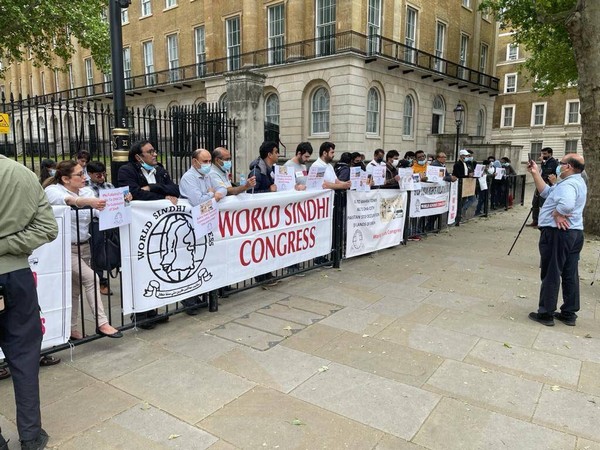Pakistan’s credibility is depleting faster than even its Forex reserves. This remark by Foreign Minister almost entirely sums up the present situation of Pakistan. Forced Disappearances is nothing new for Pakistan. A phenomenon that was 1st observed under the Military Dictator General Parvez Musharraf in 1999 has continued to wreak havoc on Pakistan’s Human Rights scenario.
The beginning of Forced Disappearance Sindhi People was with the disappearance of Mohammad Rahimoon. When GM Syed’s birthday was coming up but, he was under pressure from the government to call off public celebrations. Pakistan was under General Ziaul Haq’s military dictatorship. No political activity could be allowed – not even a celebratory event. Syed called a meeting of his senior comrades in his Sindhi nationalist movement at his native town of Sann to seek their views. Everyone favoured the cancellation. Everyone except Mohammad Rahimoon. He stood up and made a passionate argument in favour of holding the event. “I know a GM Syed who has always stood up to authority. I do not know a GM Syed who is willing to make a compromise,” he said. Syed had to let the celebrations proceed. That was 32 years ago. On February 25, 2017, Rahimoon appeared before the media in Golarchi town of Badin district to announce that he had quit politics. This was also his first appearance in public after he had gone missing on November 22, 2016.[1]
Many have had similar results. People would disappear and when they resurface, they would renounce Sindhi Nationalist activist. In April of 2017, 22 activists in Ghotki district dissociated themselves about five months later, 35 others did the same in Badin district; in September, three people in Tharparkar district’s headquarters, Mithi, renounced their links to Sindhi nationalist ideology.[2]
Nangar Channa, endured a repeat episode when even after his disappearance and subsequent public denunciation of Sindhi National Activism, he maintained contact with Activists ex-comrades and disappeared again never to be heard from.[3]
Waheed Lashari, from Larkana met with a bloody end when, after his disappearance in 2014, was found dead in 2016 in Gulshan-e-Maymar, Karachi[4]
Zakir Bozdar paid the ultimate price for ignoring this warning. Associated with the JSMM, he first disappeared in May 2012 but came back home five months later. In December 2016, he disappeared again. Five days later, his body was found in his native Ghotki district. He was 30 at the time. [5]
A US government report said that several officials from intelligence agencies, police and other security forces reportedly held prisoners incommunicado and refused to disclose their location. Pakistan’s Missing Persons Commission reported that it had opened 8,100 missing-person cases during the year and had solved 5,853 of these cases as of July.[6]
This is not just Sindh Provence but a similar travesty has hit the Balochistan Provence. Balochistan province borders Afghanistan and Iran to Pakistan’s west while Sindh province borders India in the east. The two regions of Pakistan harbours different ethnicities of people who have been waging a struggle for independence from Pakistan. The Baloch and Sindhis have been collaborating with each other in battling Pakistan, including rebel groups joining hands to attack Pakistani and Chinese projects in the two regions.
The recent abduction of Baloch nationalist Mahal Baloch by Pakistan’s Counter-Terrorism Department (CTD) from the house of a relative Bibi Gul – the chairperson of the HR Council of Balochistan (HRCB) – a human rights group based in Europe and Balochistan, has added duel to the Baloch fire. Protests have broken out in all of Balochistan against her abduction on suspicions of Mahal being a suicide bomber.[7]
With 3 separate instances of Pakistan entering the Grey List of Financial Action Task Force, and its repeated sheltering of terror outfits brought Pakistan in the limelight. Further, the repeated Forced Disappearances of the Sindhi and Baloch people, ethnic minority groups, have become a concern of Human Rights Activists throughout the World with the United Nations Working Group on Enforced or Involuntary Disappearances (WGEID) accepting a delegation by The World Sindhi Congress (WSC) and Voice for Missing Persons of Sindh (VMPS) during its 130th session in Geneva on 10th May, 2023.
Human Rights Defence International (HRDI) has taken cognizance of the gross human rights violation against Sindhi and Baloch people. Its General Secretary, Mr. Rajesh K Gogna, has written to Pakistan’s President, its Prime Minister and Chief Justice of Pakistan addressing the said issue, calling upon them to intervein and to preserve human dignity and human rights for Sindhi and Baloch ethnic minority in Pakistan.
A detailed report on missing persons can be found in The Official Report on Enforced Disappearances in Sindh by World Sindhi Congress[8]
By: Jahanvi Pathak
2nd year student
Maharashtra National Law University, Aurangabad
Intern at Human Rights Defence International
[1] https://herald.dawn.com/news/1153890/reasons-behind-the-increase-in-missing-persons-in-sindh
[2] https://thewire.in/external-affairs/reasons-behind-increase-missing-persons-sindh
[3] ibid
[4] ibid
[5] https://herald.dawn.com/news/1153890/reasons-behind-the-increase-in-missing-persons-in-sindh
[6] https://www.thestatesman.com/world/8000-people-missing-pakistan-2021-report-1503059887.html
[7] https://hindupost.in/world/sindhis-knock-at-rishi-sunaks-door-petition-against-enforced-disappearances-in-pakistan/
[8] https://www.upr-info.org/sites/default/files/country-document/2023-03/WSC_UPR42_PAK_E_Main.pdf


